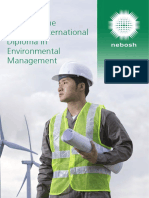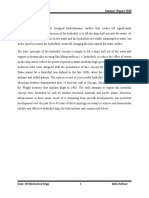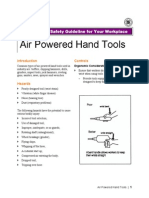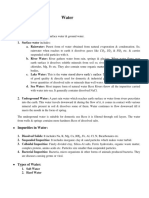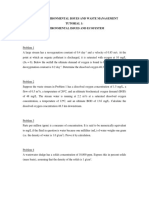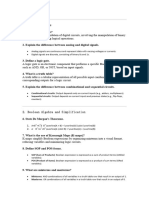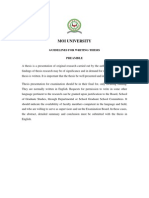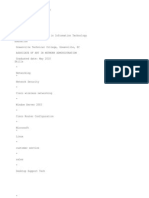Mega-Trends: Population
Mega-Trends: Population
Uploaded by
ArnavCopyright:
Available Formats
Mega-Trends: Population
Mega-Trends: Population
Uploaded by
ArnavOriginal Description:
Original Title
Copyright
Available Formats
Share this document
Did you find this document useful?
Is this content inappropriate?
Copyright:
Available Formats
Mega-Trends: Population
Mega-Trends: Population
Uploaded by
ArnavCopyright:
Available Formats
1.
Mega-trends
Introduction Population
Mega-trends relate to a wide variety of large-scale The United Nations (UN) Department of Economic
environmental, social and economic changes, varying and Social Affairs, Population Division states that
across the globe. Trends such as climate change, the global population was 7.349 billion on 1 July
population change, terrorism, big data, immigration, 2015. Various online population-estimation clocks
etc. affect all of society; however, some trends are are available based on UN data plus the current
directly related to the status of economic development population growth rate to give a ‘live’ count.
such as big data and cybersecurity.
Human population growth was fairly constant until
The following topics are included in this the start of the industrial revolution. It took all of
Learner Note: human history until 1800 for the population to reach
1 billion.
• Population
• Globalisation and Urbanisation
Milestone (bn) Year achieved Years to achieve
• Implications from Trends
2 1930 130
NB. Climate change is considered on Learner Note 2. 3 1959 29
4 1974 15
5 1987 13
6 1999 12
7 2011 12
8 Expected by 2024 13
9 Expected by 2038 14
FACTS
Global population doubled from 3 billion to 6 billion
In 1970, there were roughly half as many people as
between 1959 and 1999. It is estimated that it will take
there are today. Due to reducing growth rates, it will
a further 39 years for the population to increase by
take another 200 years to double again.
another 50%, to 9 billion by 2038.
An estimated 106 billion ‘modern’ humans have been
The UN predicts that world population will reach 10
born (over 50,000 years), meaning that 6% of all the
billion by 2056.
people who have ever lived are alive today.
Foundation Certificate in Environmental Management - Learner Notes | 1 - Mega-trends 3
IEMA-Learner Notes V6.indd 3 23/11/2016 10:57
Figure 1.1 shows the total global human population from 1950 to 2015, with projections to 2100. When planning
for future needs, mitigation and adaptation, it is essential to consider projected changes.
WORLD: Total Population
2 3 4 5 6 7 8 9 10 11 12 13 14 15 16 17
median
00% prediction interval
05% prediction interval
Population (billion)
observed
+/- 0.5 child
1950 1960 1970 1980 1990 2000 2010 2020 2030 2040 2050 2060 2070 2080 2090 2100
Source: United Nations, Department of Economic and Social Affairs, Population Divistion (2015)
World Population Prospects: The 2015 Revision. http://esa.un.org/unpd/wpp/
Top 10 largest countries by population (May 2016)
Rank Country Population Rank Country Population
1 China 1.4bn 6 Pakistan 191m
2 India 1.3bn 7 Nigeria 188m
3 USA 324m 8 Bangladesh 162m
4 Indonesia 258m 9 Russia 142m
5 Brazil 205m 10 Japan/Mexico 127m
Worldometers
4 Foundation Certificate in Environmental Management - Learner Notes | 1 - Mega-trends
IEMA-Learner Notes V6.indd 4 23/11/2016 10:57
Population density • Children are seen as a valuable source of income for
a family and society; in addition, they can help to
Population density is a measurement of the care for other children and elderly family members
population per unit area (m² or km²). Densely • High infant mortality means that many children are
populated countries include Monaco, Hong Kong (part needed to ensure that some survive
of People’s Republic of China), Singapore, Bahrain • Humans are living longer.
and Bangladesh (Source: World Bank). China has a lower
population density than the UK, for example.
Population management
Population change Population management includes a controversial and
complex mix of political, economic, environmental
Currently, the global human population is growing at and social factors.
1.13% per year, which results in an average population
increase of approximately 80 million per year (Source: Attempts have been made in a number of countries
UN). The annual growth rate peaked in 1963 (2.19%):
to control population, including India, Iran, Myanmar,
this is estimated to reduce to 1% by 2020, and to be Singapore and the USA. The most well-known was
less than 0.5% by 2050. The growth rate in China China’s ‘one-child’ policy in the late 1970s. The policy
is currently 0.52%. The countries with the highest did allow for several exceptions (e.g. if the first child
growth rates are predominantly in the Middle East and was a girl, or both parents themselves were only-
include Oman, Kuwait and Qatar. This sees a move children), with some reports suggesting that only
away from sub-Saharan Africa, albeit many of these approximately 35% of the population were subjected to
countries still make up the top 20. the strict policy.
The impact of a slowing growth rate should The Chinese government imposed fines for breaches
be positive; however, it could have significant of the policy, and tried to raise awareness. There
implications, particularly as advances in medicine were also reports of more severe methods of control,
mean that we are living longer. This could result in a particularly in rural locations, to include forced
deficit in the number of people of working age and abortion and sterilisation. Due to the preference for
an increasingly less productive, ageing population, boys, the policy resulted in a gender imbalance.
resulting in higher costs and less tax income. For
example, the UK population was 64 million in June It is very difficult to estimate how many births were
2014, and is set to rise to 70 million by 2027; however, prevented; according to the Chinese government,
the ‘over-80s’ age group is the fastest growing. the figure is 400 million. The population growth rate
was close to 2% in the late 1970s, it is now 0.52%. In
contrast, the UK growth rate is 0.63%. The policy in
There are many reasons for population growth, China was amended in January 2016 to allow couples
including: to have two children.
• Limited access to family planning services and
education about contraception
• Cultural reasons – it is important to have a large
family, and/or contraception may not be culturally
or religiously acceptable
Foundation Certificate in Environmental Management - Learner Notes | 1 - Mega-trends 5
IEMA-Learner Notes V6.indd 5 23/11/2016 10:57
Globalisation and Urbanisation What is an urban area?
“Globalisation is the process by which technological, Urban areas are defined as “places of dense human
communications and political changes have population, where most land is dedicated to buildings,
intensified the worldwide exchange of money, goods, concrete, grassy lawns and other human uses” (Pickett
people and culture.” (Faber, 2014) et al, 2001).
We have seen increased integration of economies Urban areas are sometimes referred to as ‘hardscape’.
and societies in a process that transcends national Urban areas are highly modified and complex
boundaries, which also has resulted in the landscapes within which green or open areas are seen
development of transnational regulations. as valuable for human well-being, as well as wildlife.
Habitat alteration from urbanisation is both drastic
Globalisation has resulted in an acceleration in the and increasingly widespread. Large parcels of land are
use of resources, as well as the exchange of ecological de-vegetated, paved and dramatically modified in a
hazards between nations and environmental injustices, way that often exceeds habitat changes that occur from
whereby imbalances between countries has led to logging, traditional farming and many other land uses.
affluent nations exporting ecological hazards to poor
nations. Moreover, social injustices and human rights
violations are caused through the use of cheap labour. Global middle class
Globalisation has resulted in the growth of middle
Urbanisation classes, resulting in improved quality of life, although
paradoxically this can become a problem in an
Cities, and more importantly suburbs, are expanding – interconnected global economy where quality of life
covering expanses of agricultural and ‘natural lands’. As expectation is rising, particularly if economic growth
well as population growth, a key driver for urbanisation is stagnating.
is migration: the movement of people from one
permanent place to another. This includes internal – The global middle classes are estimated to grow
rural to urban – and international migration. Migration from 2 billion to 4.9 billion by 2030 (Source: Beyond the
can bring benefits as well as challenges to both Perfect Storm, 2016) as a result of economic growth and
places, and there are various push-and-pull factors development of technology allowing us to access more
for migrants, as well as benefits and challenges for the resources and improved medical care. This increase in
place losing or gaining people. wealth has resulted in an increased demand and desire
for goods, many of which require finite resources such
as fossil fuels and rare earth elements.
FACTS
In 1900, only
In 2000, 50% By 2030, 60%
10% of humans
lived in cities will live in cities
lived in cities
6 Foundation Certificate in Environmental Management - Learner Notes | 1 - Mega-trends
IEMA-Learner Notes V6.indd 6 23/11/2016 10:57
Figure 1.2 - Growth of the global middle classes
It is estimated that the
European and American Middle Class Consumer Spending
middle classes will shrink Outer Ring: 2030 in trillions. USD (projected)
Inner Ring: 2009 in trillions. USD
from 50% to 22% of the
total. Figure 2 shows the
rapid growth in China, $11.1
Asia Pacific
India, Indonesia, Vietnam, $32.9
Thailand and Malaysia. This
will cause Asia’s share of the
Europe +571% GROWTH
new ‘middle’ to more than $8.1 While increasing Chinese
$5.6
double from its current 30%. spending tops the news, the East
Asia Bureau of Economic
By 2030, Asia will host 64% Research forecasts that spending
North America $4.9 in India and Indonesia will grow
of the global middle class, at similar rates.
$5.5
and account for more than
40% of global middle-class Sub-Saharan Africa $0.4
$1.5
consumption $0.6
$0.9
$3.3
(Source: Reuters). Middle East and $2.2 Central/
North Africa South America
REGIONS
Source: OECD
New markets: a pivot to the Asia-Pacific market
Another consequence of globalisation is a growth as ‘developing’, ‘major emitters’ and ‘major
in emerging economies, resulting in new markets economies’. They have global economic and
being opened up and a pivot to the Asia-Pacific political power. So, at what point are these
region. The International Monetary Fund (IMF) countries no longer ‘less developed’, and when
reported that in 2000, the area accounted for less should they be regarded the same as ‘more
than 30% of global output, but by 2014 this had risen developed’ nations? Despite now committing to
to almost 40%, as well as accounting for two-thirds greenhouse gas emission (GHG) reductions, the
of global growth. BASIC group argues that ‘developed’ countries
continue to have much higher per capita
The real conflict is in the roles and emissions, and that they still have a long way to
responsibilities of the emerging powers go to achieve reasonable living standards and
(newly industrialised countries) – Brazil, South eradicate poverty, thus emissions should be able
Africa, India and China (known as the BASIC to continue to grow.
group). The BASIC countries can be classed
Foundation Certificate in Environmental Management - Learner Notes | 1 - Mega-trends 7
IEMA-Learner Notes V6.indd 7 23/11/2016 10:57
Implications from Trends Resource consumption (and intensity),
Population structure scarcity and depletion
Different countries face varying problems when faced With an estimated population of more than 8 billion
with managing population change. Less Economically by 2030, we will need 50% more energy, 40% more
Developed Countries (LEDC) have to manage water and 34% more food (Source: National Intelligence
rapid population growth, while More Economically Council). This is a combination of a greater number
Developed Countries (MEDC) have to manage slow or of people and more intense resource consumption.
negative growth and an ageing population. Changes The intensity of resource use between 1900 and 2000
in the structure of the population, coupled with an increased by a factor of 12 for fossil fuels, and a factor
increase in life expectancy, lead to fewer economically of 8 for all resources overall. The intensity of resource
active people to support an elderly population. This consumption between 1900 and 2000 outstripped
results in increasing pressure on resources, and population growth by a rate of 3.75.
paradoxically, may result in more countries adopting
pro-natalist policies and offering incentives.
World Energy Consumption
Figure 1.3 World energy
600
consumption
500
Nuclear
Hydro-Elect
This shows the huge increase in world
Exajoules per Year
Nat Gas
400
Oil
energy consumption that has taken
Coal
place in the last 200 years. This rise in 300
Biofuels
energy consumption is primarily from 200
increased fossil fuel use.
100
Source: Our Finite World 0
1820 1840 1860 1980 1880 1900 11920 1940 1960 1980 2000
World per Capita Energy Consumption
Figure 1.4 World energy
90
consumption
80
(per capita)
Gigajoules per Capita per Year
Nuclear
70 Hydro-Elect
Nat Gas
60
This shows world energy consumption Oil
50 Coal
per person (capita), which resonates Biofuels
40
with the previous observation that the
30
intensity of resource use is as much a
20
factor as total population.
10
0
Source: Our Finite World 1820 1840 1860 1980 1880 1900 11920 1940 1960 1980 2000
8 Foundation Certificate in Environmental Management - Learner Notes | 1 - Mega-trends
IEMA-Learner Notes V6.indd 8 23/11/2016 10:57
One way of measuring this is to consider our Biodiversity loss and ecosystem decline
ecological footprint. An ecological footprint looks
at the amount of resources we use. Similarly, if we There are estimated to be 8.7 million species (give
consider the biocapacity of the planet to provide, then or take 1.3 million and excluding bacteria) on Earth
it is accepted that our ecological footprint exceeds (Source: UNEP). Current extinction rates are estimated
the Earth’s biocapacity to provide. to be 1,000 times the background rates. It has been
argued that the Earth is currently in its sixth ‘Mass
If the Earth’s footprint is expressed in terms of months Extinction Episode’, with the previous one being
of the year, then globally the human population uses dinosaur extinction 65 million years ago.
up its resource allocation by September. If looking
at the UK population only, we exceed the Earth’s It is highly likely that there are species going extinct
biocapacity by April, and the USA by February. This is that we are not even aware of, and have not had
known as ‘overshooting’ or ‘ecological debt’. the opportunity to assess their contribution to the
functioning of ecosystems, or even the services that
Resource depletion they might provide.
This is the use of raw materials at a rate higher than Biodiversity refers to ‘the variety of life’ (Gaston and
their replacement within an area, region or country Spicer, 2004). The UN Convention on Biological
– many of these resources are non-renewable (e.g. Diversity provides the following definition:
fossil fuels). Research published in Energy Policy
(2009) suggests that reserves of oil and gas will have “’Biological diversity’ means the variability among
diminished by 2042; coal will be available up to 2112. living organisms from all sources including, inter alia,
terrestrial, marine and other aquatic ecosystems and
Rare earth elements the ecological complexes of which they are a part; this
includes diversity within species, between species
Rare earth elements are a key resource, called such and of ecosystems.”
because of their difficultly to extract and often
sparse distribution, rather than the limited total • Genetic: Populations, individuals, chromosomes,
amount. These include 17 chemical elements, the 15 genes, nucleotides
lanthanides as well as scandium and yttrium. They
• Organismal: Kingdoms, phyla, families, genera,
are used in a wide range of electrical and electronic
species, sub-species, populations, individuals
devices, from mobile phones and computers to
solar panels, hybrid cars, and in military and medical • Ecological: Biomes, bioregions, landscapes,
applications. An estimated 95% of these elements are ecosystems, habitats, niches, populations.
produced by China, despite having 20% to 30% of rare
earth element global reserves. In addition to these Maintaining biodiversity is important because
elements, many other important elements such as human survival depends on it to support life on
gold, platinum and silver are used in electrical and our planet, and because of the services it provides
electronic equipment manufacturing. (see Learner Note 8). However, humans are directly
(e.g. harvesting) or indirectly (e.g. climate change,
pollution) responsible for reducing biodiversity, and
for placing many other species at risk.
Foundation Certificate in Environmental Management - Learner Notes | 1 - Mega-trends 9
IEMA-Learner Notes V6.indd 9 23/11/2016 10:57
Genetic diversity is the foundation for all Global imbalances
biological diversity
The total human population, its change, distribution,
The genome contains the genetic code of an structure and our social and economic expectations
individual. A gene is a section of DNA whose are significant drivers for change. This is resulting in
sequence determines the structure and function of a a number of environmental, social and economic
specific functional molecule (usually a protein). The consequences (as laid out in this Learner Note). The
gene information is encoded into building blocks and image below highlights the imbalances that still exist.
the code varies between individuals – this is genetic
diversity. A high genetic diversity increases the
likelihood of species survival.
Figure 1.5 Source: Beyond the Perfect Storm
Water
An estimated 1.8 billion people are
drinking water contaminated by
faeces; between 1990 and 2012
2.3 billion people gained access to Human rights
improved drinking water An estimated 35.8 million
people globally are defined as
modern slaves
Poverty
One person in five in developing
regions earns less than $1.25 a day; in
‘rich’ countries there has been a net Climate change
increase of 2.6 million in the number In 2015, global warming reached
of children in poverty since the 2008; 1°C above pre-industrial times for
76.5 million children live in poverty in the first time; 1.6 billion people
the 41 most affluent countries live in countries and regions with
absolute water scarcity – with
climate change this is expected to
rise to 2.8 billion by 2025
Education Health and wellbeing
57 million children worldwide 2.5 billion people globally lack
are not in school, half of them in access to basic sanitation;
conflict-affected areas; 103 million millions have no access to soap
youth (more than 60% of them and water to wash their hands,
women) lack basic literacy skills denying a basic act that would
empower them to block the
spread of disease
Pollution
Global output of chemicals increased Biodiversity
84% between 2000 and 2010; Species loss is estimated to
4.9 million deaths worldwide were be between 1,000 and 10,000
attributable to exposure to chemicals times higher than the natural
in 2004; plastics weighing 191 times extinction rate
that of the Titanic are dumped in
oceans each year
Population
Global population will grow from
7.2 billion to 9.7 billion by 2050; global
middle class will grow from 2 billion to
4.9 billion by 2030; in the next 40 years
Resources we have to produce as much food as
The circular economy represents over the past 8,000 years
a net material cost saving
opportunity of between $340bn Statistics sourced from the UN,
and $380bn a year to the EU UNICEF, WHO, The World Bank, WWF,
The Global Slavery Index, UNEP, Ellen
MacArthur Foundation, OECD and Reuters.
10 Foundation Certificate in Environmental Management - Learner Notes | 1 - Mega-trends
IEMA-Learner Notes V6.indd 10 23/11/2016 10:57
Further information
National Intelligence Council – Global Trends
www.dni.gov/index.php/about/organization/national-intelligence-council-global-trends
Population statistics
www.worldometers.info
United Nations Department of Economic and Social Affairs, Population Division
www.un.org/en/development/desa/population/
PwC Megatrends
www.pwc.co.uk/issues/megatrends.html
Ernst and Young Global Megatrends
www.ey.com/GL/en/Issues/Business-environment/EY-megatrends
Foundation Certificate in Environmental Management - Learner Notes | 1 - Mega-trends 11
IEMA-Learner Notes V6.indd 11 23/11/2016 10:57
2. Climate Change
The following are • The Science and Causes of Climate Change • Global Emissions
included in this • Impacts/Consequences of Climate Change • Case Study - UK Response
Learner Note:
• Global Action
The Science and Causes of Climate Change
Climate change is a complex science and causes much confusion. Here are a few simple definitions to
distinguish between the key terms used.
The Greenhouse Effect is the heating of the surface of the Earth due to the
presence of an atmosphere containing greenhouse gases (GHG) (carbon dioxide,
water vapour, methane, nitrous oxide, hydro chlorofluorocarbons [HCFCs])
that absorb and emit long-wave (heat) radiation. Without the effect, the Earth’s
average temperature would be −19oC, rather than 15oC, and the effect is natural.
However, human activity is exacerbating the effect, causing global warming by
increasing the amount of GHG in the atmosphere.
Global warming is the process by which the average surface temperature on the
Earth increases. This is caused primarily by an increase in the amount of GHG in
our atmosphere. Global temperatures increased by 0.85 degrees between 1880
and 2010. (Source: IPPC)
Climate change is a change in the long-term distribution and severity of weather
patterns caused by changes in global temperature.
12 Foundation Certificate in Environmental Management - Learner Notes | 2 - Climate Change
IEMA-Learner Notes V6.indd 12 23/11/2016 10:57
Greenhouse gases
GHG have varying global warming potentials (GWP),
a measure used to compare the emissions from
Some solar radiation is
reflected by the Earth
and the atmosphere SUN various GHG. This means that we need to consider
the types and amounts of each greenhouse gas in our
atmosphere. If measured over 100 years and CO2 is
Solar radiation worth 1, then methane is approximately 25 times more
passes through the
clear atmosphere powerful than CO2, nitrous oxide is approximately 300
times more powerful, and a perfluorinated compound
known as sulphur hexafluoride (SF6) used in industry is
Most radiation is
absorbed by the Earths ATMOSPHERE approximately 23,000 times more powerful than CO2.
surface and warms it
EARTH Some infrared radiation is
absorbed and re-emitted
by the greenhouse gases.
The effect of this is to
Carbon dioxide
Infrared radiation warm the surface and
is emitted from the lower the atmosphere
Earth’s surface CO2 forms approximately 0.04% of the Earth’s
atmosphere (400 ppm) - it is essential for life. The
current levels are 125 ppm above the 1,832 ice core
levels. Using ice-core data, we know that there is
Our atmosphere now more CO2 in our atmosphere than at any point
in the past 800,000 years. Even if we could reduce
More than 99% of the atmosphere is made up of
CO2 emissions, CO2 concentrations would continue
nitrogen, oxygen and argon, and the levels of these
to rise due to lag effects; taking 20 to 30 years to
atmospheric gases have been stable for millennia. The
translate into warming.
remaining constituents of the atmosphere are termed
‘variable trace gases’ and these are dominated by GHG
(HCFCs are used in air conditioning equipment and
industrial processes). GHG are capable of absorbing and
re-emitting wavelengths of electromagnetic radiation
(i.e. the same heat energy that radiates from a fire).
Foundation Certificate in Environmental Management - Learner Notes | 2 - Climate Change 13
IEMA-Learner Notes V6.indd 13 23/11/2016 10:57
Causes of climate change When measuring future climate, we
Climate change is both natural, including also need to consider the following:
variations in solar output, the Earth’s orbit, • Future population increases and rises in the
volcanic eruptions and the natural carbon cycle global middle class – the increasing intensity
(see Learner Note 7) and man-made. About 80% of of resource use magnifies this.
human CO2 emissions during the 1990s resulted
• The finite capacity of the biosphere to
from burning fossil fuels and cement production,
absorb CO2 means that it will not always
with the remaining 20% from land-use change
be there to act as a buffer. This can result in
(primarily deforestation). Almost 45% of these
positive feedback mechanisms.
emissions have remained in the atmosphere.
Oceans have taken up 30%, and terrestrial • Lag effects – emissions realised today will
ecosystems have taken up the rest through cause warming in 20 to 30 years.
growth of replacement vegetation on cleared land, • We are adding to the CO2 already in the
changes to land management practices, and the atmosphere – reducing emissions is not
fertilising effects of increased CO2 and nitrogen taking CO2 out.
depositions.
Impacts and Consequences of Climate
Climate change by numbers Change
The impacts of climate change are usually felt
• 0.85 degrees of global warming since 1880.
locally and are unevenly distributed. Impacts
• Scientists are 95% sure that half of global include, but are not limited to:
warming is caused by humans – a halving
or doubling of CO2 can cause a 4⁰ change.
• Warming of the climate system, resulting in an
Temperature rises are proportional to CO2.
increase in the incidence of heatwaves and/or
• 1 trillion tonnes – this is the amount of stress
carbon we can use and potentially keep below
• Snow and ice diminishing, resulting in sea level
2 degrees of warming: a ‘world carbon budget’.
rises, land loss and flooding
We have already used half a trillion, and are
projected to use the other half within 30 years. • More severe weather and pattern changes,
causing damage to property and crops,
(Source: IPPC)
cyclones, mudslides and forest fires
• Increasing ocean acidity, resulting in damage
to sensitive habitats and species
• Changes in vegetation zones, resulting in
desertification and reduced crop yields
• Changes in the distribution of disease vectors
– increasing the spread and/or incidence of
disease and epidemics
• Change to natural systems, loss of biodiversity
and ecosystems.
14 Foundation Certificate in Environmental Management - Learner Notes | 2 - Climate Change
IEMA-Learner Notes V6.indd 14 23/11/2016 10:57
Global Action
1988
The Intergovernmental Panel on Climate
Change (IPCC) was created. It was set up by the
World Meteorological Organization (WMO) and
the United Nations Environment Programme
(UNEP) to prepare, based on available scientific
information, assessments on all aspects of
climate change and its impacts, with a view to
formulating realistic response strategies.
1992
A key development behind climate change policy
was the United Nations Framework Convention
on Climate Change (UNFCCC), an international
treaty negotiated at the Earth Summit in Rio de
Janeiro in 1992. A key objective was to “stabilise
GHG concentrations in the atmosphere to a
level that would prevent dangerous human
Other commitments of the interference with the global climate system”. The
UNFCCC include: treaty sets out a broad framework of objectives,
guiding principles and commitments for
• Publishing GHG inventories participating countries to tackle climate change
• Implementing measures to mitigate and at a global level. It did not set any binding targets
adapt to climate change or establish enforcement mechanisms, but set
the way for future mechanisms (see reference to
• Promoting and cooperating in the
‘1997 Kyoto Protocol’).
development, application, diffusion of
mitigation or adaptation technologies
It was agreed that parties should protect the
• Promoting sustainable development climate system for the benefit of present and
future generations, on the basis of respective
• Taking care to minimise the adverse
capabilities and responsibilities; developed
socio-economic or environmental effects
parties being responsible for the majority of GHG
that responding to climate change might
emissions should take the lead in combating
bring about
climate change.
• Promoting and cooperating in relevant
scientific research and technology It was agreed that from 1995, the parties to the
• Promoting and cooperating in education, agreement should meet annually in Conferences
training and public awareness. of the Parties (CoP) to discuss progress and action
required to tackle climate change.
16 Foundation Certificate in Environmental Management - Learner Notes | 2 - Climate Change
IEMA-Learner Notes V6.indd 16 23/11/2016 10:57
1997: Kyoto Protocol
(CoP 3, 1997)
• Developed (industrialised) countries were set
a target of reducing GHG emissions by 5.2%
between 2005 and 2012 – targets varied by
country (e.g. EU: 8%, UK: 12.5%). Developing
countries were not set targets. The USA did
not sign up
• Targets covered all GHGs, not just CO2
• Targets were legally binding – failure to
comply would incur penalties
The Protocol ‘operationalises’ the UNFCCC,
but due to complex ratification processes it
only entered into force in February 2005. The
Protocol committed industrialised countries
to stabilise GHG based on the principles of
the Convention. Developed countries insisted
on a numberr o of “flexibility mechanisms” to
allow them to o meet their targets in the most 2015: Paris Agreement
economically ly effective way (CoP 21)
• This was signed in April 2016 and deals with
GHG emission mitigation, adaptation and
finance from 2020; it also adopts a pledge and
review system discussed in earlier meetings
and championed by the USA and China
• A commitment to keep global warming to
below 2°C; discussions suggested that a new
limit of 1.5°C should be established
• The Agreement was signed by 177 UNFCCC
members, 15 of which ratified it. Importantly,
the USA and China, which jointly represent
40% of global emissions, confirmed that they
will sign the Agreement
Foundation Certificate in Environmental Management - Learner Notes | 2 - Climate Change 17
IEMA-Learner Notes V6.indd 17 23/11/2016 10:57
Methods to tackle climate change Carbon markets
Mitigation – reduce the magnitude of Carbon markets put a commodity value on GHG
climate change emissions – emissions trading, carbon taxes and
voluntary offset have become strategies because they
This means using cleaner energy sources, such as claim to deliver economically efficient reductions in
renewables, reducing reliance on fossil fuels, building GHG emissions. The EU Emissions Trading Scheme
a smart electrical grid, investing in carbon capture (EU ETS) is a mandatory multi-sector, multi-country
and sequestration (storage) (CCS) and potentially cap and trade scheme that is the EU’s primary
other geo-engineering technologies that either instrument for regulating carbon emissions from large
remove GHG from the atmosphere, or solar radiation energy and industrial installations. Large emitters of
management that reflects some of the inbound carbon are given a specific ‘allowance’; if they exceed
sunlight back into space, with the effect of reducing that allowance, they need to buy carbon credits from
global warming. those who may have not used their allowance.
The nature of the scheme incentivises companies
Adaptation - Adapt to the consequences financially to reduce their emissions, and assist
of a changing climate and limit member countries in meeting their emission
vulnerability reduction targets.
This means preparing to live with the effects of As well as mandatory schemes, carbon is traded
climate change, some of which are under way or voluntarily, whereby credits are allocated to projects
inevitable. Adaptation is both a technical and a that are carbon ‘positive’, thus allowing businesses,
political challenge. Technical adaptation means countries and individuals to purchase carbon credits
transforming our relationship with nature as nature and offset their emissions.
transforms. Examples include:
• building seawalls around vulnerable coastal cities;
• giving land back to mangroves and everglades, so
they can act to break tidal surges during storms;
• opening wildlife migration corridors, so that species
can move as the climate warms; and
• developing sustainable forms of agriculture that
can function on an industrial scale, even as weather
patterns vary wildly.
18 Foundation Certificate in Environmental Management - Learner Notes | 2 - Climate Change
IEMA-Learner Notes V6.indd 18 23/11/2016 10:57
Global Emissions
Global emissions in 2010 were 49 billion tonnes CO2 (Source: IPPC).
GHG (CO2e) emissions per territory, 2010 as a % of total emissions (top 10)
Rank Country % Rank Country % Rank Country %
1 China 22.7 5 Japan 2.9 9 Canada 1.7
2 USA 15.5 6 Brazil 2.6 10 Iran 1.6
3 India 5.7 7 Germany 2.1 13 UK 1.4
4 Russia 5.4 8 Indonesia 1.9
Source: World Resources Institute
CO2 emissions, tonnes per capita per territory, 2010
Rank Country T Rank Country T Rank Country T
United Arab
1 Qatar 40.1 6 22.3 11 Bahrain 19.2
Emirates
Trinidad and
2 37.8 7 Aruba 21.6 12 USA 17.5
Tobago
3 Kuwait 34.2 8 Luxembourg 21.3 44 UK 7.96
4 Netherland Antilles 23.6 9 Oman 20.6 59 China 6.18
5 Brunei Darussalam 23 10 Falkland Islands 19.6 119 India 1.64
Source: UN Millennium Development Goals Indicator
Preliminary data for 2015 from the International Energy Agency showed that global emissions of CO2 (not
all GHG) from energy generation have levelled off at 32.1 billion tonnes due to a reduction in coal-generated
power coupled with a rise in renewable energy, despite the global economy growing by 3% during the same
period. (Source: Guardian, 16 March 2016)
Foundation Certificate in Environmental Management - Learner Notes | 2 - Climate Change 19
IEMA-Learner Notes V6.indd 19 23/11/2016 10:57
CASE STUDY - UK RESPONSE
In terms of energy generation, the UK has reduced UK activity includes the Climate Change Act 2008,
its reliance on coal and replaced it with gas and which set a GHG reduction target of 80% by 2050.
renewables. In 2016, for the first time since before The UK was the first to set a carbon reduction law;
the Industrial Revolution, the UK operated without more than 80 other countries have now set targets.
any coal-fired power generation. As we move The diagram below shows how UK total GHG
forward, gas (including shale) will continue to play a emissions have been decreasing over recent years.
key role, supplemented by nuclear and renewables.
Figure 2.1 Total UK GHG emissions between 1990 and 2014
MtCO2e
1000.0
800.0
600.0
400.0
200.0
0.0
1990
1991
1992
1993
1994
1995
1996
1997
1998
1999
2000
2001
2002
2003
2004
2005
2006
2007
2008
2009
2010
2011
2012
2013
2014
Source: Extracted from GOV.UK National Statistics
Further information
See Learner Note 1.
Intergovernmental Panel on Climate Change (IPPC)
www.ipcc.ch
International Energy Agency
www.iea.org
The Keeling Curve
scripps.ucsd.edu/programs/keelingcurve/
UK GHG emissions data
www.gov.uk
UK Met Office Climate Guide
www.metoffice.gov.uk/climate-guide
20 Foundation Certificate in Environmental Management - Learner Notes | 2 - Climate Change
IEMA-Learner Notes V6.indd 20 23/11/2016 10:57
3. Sustainable Development
and Sustainability
The following are included in • Definition of Sustainable Development
this Learner Note:
• History of Sustainable Development
• United Nations Sustainable Development Goals
• Sustainable Development Concepts
• Environmental Limits and the Planetary Boundaries Concept
• Sustainable Capitals
Definition of Sustainable Development
There are said to be more than 200 definitions Individual jurisdictions tend to have their own
of sustainable development. However, the most definition, albeit following the Brundtland principles.
common definition is: Due to the number of definitions, sustainability is
considered a ‘contested concept’: an idea that a
“Meeting the needs of the present without particular concept does not have an agreed, fixed
compromising the ability of future generations to definition. If contested, then different groups may
meet their own needs.” define or reframe the concept to suit their objectives.
As a consequence, it is common to see the term
This is known as the Brundtland definition, after Gro ‘sustainability’ added to other phrases or industries,
Harlem Brundtland, chair of the World Commission including aviation, construction and landfill.
on Environment and Development.
The Global Association of Corporate Sustainability
Officers (GACSO) defines sustainable development as:
“Being able to meet our needs today, while ensuring
that what we leave behind for future generations is
sustainable, for people and the planet.”
A simpler alternative suggested by Newcastle
University and presented in the GACSO Defining
Corporate Sustainability white paper is “Enough, For
All, Forever”.
22 Foundation Certificate in Environmental Management - Learner Notes | 3 - Sustainable Development and Sustainability
IEMA-Learner Notes V6.indd 22 23/11/2016 10:57
History of Sustainable Development
Sustainable development is an extremely important yet simple concept, emphasised by the reported fact that if
everyone in the world consumed as many natural resources as the average person in the UK, we would need
3 planets to support us – or if we lived the average USA lifestyle, we would need 5 planets. Despite, its apparent
simplicity, sustainable development can be extremely difficult to explain or apply to everyday life, as well as
knowing when it has been achieved.
1972
The UN Conference on the Human Environment
in Stockholm: The Concept of Sustainable
Development is widely accepted to have its 1987
origins here. The Brundtland Report rt – the concept gained
momentum following g tthe Brundtland Report,
Our Common Future, which
w suggested that
sustainable development was the solution to
the problem of environmental degradation:
namely, that human activity was having severe
1992 and negative impacts on the planet, and that
The UN Conference
ere on Environment and patterns of growth and development would be
Development (U (UNCED), at Rio – world leaders unsustainable if they continued unchecked.
recognised sustainable
sta development as a
major challenge.
ge The summit marked the
first international
nal attempt to draw up action
plans for moving towards a more sustainable
pattern of development. It was attended by
representatives from 178 governments, and
set out ‘Agenda 21’, which included various 2002
voluntary sustainable development goals to be
The World Summit on Sustainable e Development
Dev
achieved in the 21st Century.
in Johannesburg – the Summit mit delivered
deli
3 key outcomes: a politicall decla
declaration, the
Johannesburg Plan of Implementation,
Imple
tnersh initiatives. Key
and a range of partnership
2012 lud those on consumption
commitments included
at and sanitation and energy.
and production, water
The Rio+20 Summit – governments reaffirmed
their commitments to the previous sustainable
development agreements and targets. They
also committed to developing Sustainable
Development Goals (see overleaf) building
on Agenda 21 and Johannesburg Plan of
Implementation.
Foundation Certificate in Environmental Management - Learner Notes | 3 - Sustainable Development and Sustainability 23
IEMA-Learner Notes V6.indd 23 23/11/2016 10:57
United Nations Sustainable Development Goals
At the UN Sustainable Development Summit on 2015). The sustainable development goals seek to
25 September 2015, world leaders adopted the address the root causes of poverty, and the universal
‘2030 Agenda for Sustainable Development’, which need for development that works for all.
includes 17 sustainable development goals to end
All 17 goals are connected to the United Nations
poverty, fight inequality and injustice, and tackle
Development Programme’s (UNDP) strategic plan
climate change by 2030.
that focuses on sustainable development, democratic
These goals build on the Millennium Development governance and peace building, and climate change
Goals set in 2000 (which had 8 anti-poverty targets and disaster resilience.
that the world initially committed to achieving by
Figure 3.1: United Nations Development Programme (UNDP):
Each goal is
supported by a
number of targets,
which are available on
the UNDP website.
1. End poverty in all its forms, everywhere. 11. Make cities and human settlements inclusive safe,
2. End hunger, achieve food security and improved resilient and sustainable.
nutrition and promote sustainable agriculture. 12. Ensure sustainable consumption and production
3. Ensure healthy lives and promote well-being for all at patterns.
all ages. 13. Take urgent action to combat climate change and its
4. Ensure inclusive and equitable quality education and impacts.
promote lifelong learning opportunities for all. 14. Conserve and sustainable use of the oceans, seas and
5. Achieve gender equality and empower all women marine resources for sustainable development.
and girls. 15. Protect, restore and promote sustainable use of
6. Ensure availability and sustainable management of terrestrial ecosystems, sustainable manage forests,
water and sanitation for all. combat desertification, and halt and reverse land
degradation and halt biodiversity loss.
7. Ensure access to affordable, reliable, sustainable and
modern energy for all. 16. Promote peaceful and inclusive societies for
sustainable development, promote access to justice
8. Promote sustained, inclusive and sustainable for all and build effective, accountable and inclusive
economic growth, full and productive employment institutions at all levels.
and decent work for all.
17. Strengthen the means of implementation and
9. Build resilient infrastructure, promote inclusive and revitalise the global partnership for sustainable
sustainable industrialisation and foster innovation. development.
10. Reduce inequality within and among countries. Source: UNEP
24 Foundation Certificate in Environmental Management - Learner Notes | 3 - Sustainable Development and Sustainability
IEMA-Learner Notes V6.indd 24 23/11/2016 10:57
Sustainable Development Concepts
The Brundtland Commission highlighted Common governing principles to achieve sustainable
two key concepts: development include:
1. ‘Needs’ – the essential needs of the world’s • Living within environmental limits or planetary
poorest people, which should be given overriding boundaries
priority. • Integrated (and complementary) decision making
2. ‘Limitations’ – imposed by the state of • Governance that is democratic, transparent,
technology and social organisation on the inclusive, participatory and accountable
environment’s ability to meet both present and
• Responsible use of robust and credible scientific
future needs.
evidence in decision-making.
This supports the central idea that sustainable
‘Sustainability’ can be defined through the 3 Pillars
development is about intergenerational equity: that
approach: Economic, Social and Environmental.
needs are basic and essential, economic growth will
facilitate their fulfilment, and equity is encouraged by
Sometimes the 3 pillars are referred to as the
participation.
triple bottom line: all three have to be resolved
for sustainability to be achieved. This means that
sustainability is very broad, and only focusing on
one or two areas does not consider the full range of
issues. Sustainable development is the ‘pathway to
sustainability’.
Figure 3.2: Sustainability also be looked at using the
following model from Raworth (2012):
Environment
A viable natural world
Social Nuturing Economic
community Sufficient Economy
Sustainable natural Sustainable economic
and built environment development
Foundation Certificate in Environmental Management - Learner Notes | 3 - Sustainable Development and Sustainability 25
IEMA-Learner Notes V6.indd 25 23/11/2016 10:57
Figure 3.3:
change
Beyond the Perfect Storm, a report published by climate
MENTAL CEIL fre
ge R O N sh
IEMA, suggested that the key challenges include: an VI ING w
ch EN at
er
se
just space for
us
nd
nd
e
• The rights and responsibilities of current and future hu
ea
la
f L FOUNDATIO m
a OCIA N
generations S
an
es
water
ph
nit horus cycles
food
osp
ity
th
loss
roge
income
• Environmental limits in meeting current and future
biodiversity
n and
health
education
generations gender
equality resilience
• Social value and/or social protection floor social
ocea
equity
T
voice
IN
MN
n
CL
n
tio
• The resilience of society and economy energy jobs
PE
ac
US
pic
LO
i
IV
E
d
de AN VE
iti
D DE
ca
ne
• Values, ethics and quality of life SU
MI
C
tio
o STA
oz INA B L E E C O N O
n
ch
• Dependencies and mega-trends
em
ica
ol l po
ing os llutio
load c aer n
pheri
atmos
• The need for new economic and business models.
Environmental Limits and the Planetary Boundaries Concept
The concept of ‘Environmental limits’ and ‘planetary boundaries’ was established by the Stockholm Resilience
Centre in 2009 (updated in 2015) to define a “safe operating space for humanity” as a pre-condition of
sustainable development. It was based on research from the 1970s suggesting that population, pollution, food
production, industrialisation and resource depletion grow exponentially, compared to technology’s ability to
increase resource availability and efficiency, only growing linearly.
Scientists at the Stockholm Resilience Centre identified 9 Earth system processes which have boundaries:
Figure 3.4: http://science.sciencemag.org/content/347/6223/1259855
Generic Climate change
diversity
Biosphere integrity
Novel entities
Functional
diversity
Land-system Stratospheric ozone depletion
change
Atmospheric aerosol loading
Freshwater use
Phosphorus
Nitrogen Ocean acidification
Biochemical flows
Beyond zone of uncertainty (high risk) Below boundary (safe)
In zone of uncertainty (increasing risk) Boundary not yet quantified
26 Foundation Certificate in Environmental Management - Learner Notes | 3 - Sustainable Development and Sustainability
IEMA-Learner Notes V6.indd 26 23/11/2016 10:57
Earth-system Boundary Current
Control variable
processes value value
Atmospheric carbon dioxide concentrations (ppm) 350 >400
1. Climate
change* Increase of top-of-atmosphere radioactive forcing (Wm2)
+1.0 +2.3
relative to pre-industrial levels (1750)
2. Change
Biodiversity loss and extinction rate (no. of species per
in biosphere 10 100-1000
million per year)
integrity*
3. Stratospheric
Stratospheric ozone concentration (Dobson units) 290 200
ozone depletion
4. Ocean Global mean saturation state of aragonite in surface seawater
2.65 2.90
acidification (omega units)
Phosphorus flow from freshwater systems to oceans (millions
5. 11 22
of tonnes per year)
Biogeochemical
/ biochemical
Nitrogen fixation (industrial and biological) (millions of
flows 62 150
tonnes per year)
6. Land-system
Area of forested land as a percentage of original forest cover 75 62
change
7. Freshwater use Global human consumption of water (km3/yr) 4,000 2,600
8. Atmospheric Overall particulate concentration in the atmosphere, on as
? ?
aerosol loading regional basis
9. Introduction of Concentration of organic pollutants, radioactive materials,
? ?
novel entities nanomaterials and micro-plastics in the environment
*Known as ‘core boundaries’. Significantly altering either of these would drive the Earth system in a new state.
As of that published in Science by Steffen et al (2015), 4 of the boundaries have been exceeded.
Foundation Certificate in Environmental Management - Learner Notes | 3 - Sustainable Development and Sustainability 27
IEMA-Learner Notes V6.indd 27 23/11/2016 10:57
Sustainable Capitals
There are 5 types of sustainable capitals from which we derive the goods and services needed to improve
the quality of lives.
1. Natural - any stock or flow of energy or material that produces goods or services. It includes: resources
(renewable and non-renewable), sinks (that absorb, neutralise or recycle waste) and processes (such as
climate regulation).
2. Human - people’s health, knowledge, skills and motivation. All are needed for productive work.
3. Social - institutions that help maintain and develop human capital in partnership with others, e.g. families,
communities, businesses, trade unions, schools and voluntary organisations.
4. Manufactured - material goods or fixed assets which contribute to the production process rather than
being the output itself – e.g. tools, machines and buildings.
5. Financial - enables the other capitals to be owned and traded. This has no value itself, but represents
natural, human, social or manufactured capital, e.g. shares, bonds or banknotes.
Manufactured Capital
Financial Capital
Social Human
Capital Capital
Natural Capital
28 Foundation Certificate in Environmental Management - Learner Notes | 3 - Sustainable Development and Sustainability
IEMA-Learner Notes V6.indd 28 23/11/2016 10:57
The features of a sustainable society include the following.
In their extraction and use, substances taken from the Earth do not exceed the
environment's capacity to disperse, absorb, recycle or otherwise neutralise their effects
Natural In their manufacture and use, artificial substances do not exceed the environment's
capacity to disperse, absorb, recycle or otherwise neutralise their harmful effects
The environment’s capacity to provide ecological system integrity, biological diversity and
productivity is protected or enhanced
At all ages, individuals enjoy a high standard of health
Individuals are adept at relationships and social participation, and set and achieve high
Human
personal standards of their development and learning throughout life
Access to varied and satisfying opportunities for work, personal creativity, and recreation
There are trusted and accessible systems of governance and justice
Communities and society at large share key positive values and a sense of purpose
Social
Society promotes stewardship of natural resources and people development
Homes, communities and society provide safe, supportive living and working
environments
Infrastructure, technologies and processes minimise the use of natural resources and
Manufactured
maximise human innovation and skills
Finance Financial capital accurately represents the value of the other capitals
Source: Forum for the Future
Further information
See Learner Note 1.
Beyond the Perfect Storm: The Corporate Sustainability Challenge
Available from www.iema.net
Forum for the Future
www.forumforthefuture.org
Stockholm Resilience Centre
www.stockholmresilience.org
United Nations Development Programme (UNDP)
www.undp.org
United Nations Sustainable Development Knowledge Platform
sustainabledevelopment.un.org/index.php?menu=122
Foundation Certificate in Environmental Management - Learner Notes | 3 - Sustainable Development and Sustainability 29
IEMA-Learner Notes V6.indd 29 23/11/2016 10:57
You might also like
- Ozoudeh ChukwuemekaDocument76 pagesOzoudeh ChukwuemekaCywoo UDEH100% (3)
- Safe Use of Solvent Degreasing Plant: HSE Information SheetDocument6 pagesSafe Use of Solvent Degreasing Plant: HSE Information SheetdavidrimingtonNo ratings yet
- ED2 - Application of Environmental Risk Theory and PracticeDocument1 pageED2 - Application of Environmental Risk Theory and PracticeshaistaNo ratings yet
- MS Excel Word Powerpoint MCQsDocument64 pagesMS Excel Word Powerpoint MCQsNASAR IQBAL50% (2)
- Nebosh National Diploma Examiners Report July 2012 Unit BDocument14 pagesNebosh National Diploma Examiners Report July 2012 Unit BPudeti RaghusreenivasNo ratings yet
- 2024 Training ProgrammeDocument36 pages2024 Training ProgrammeJhanzaib ahmed gujar bajarNo ratings yet
- CV. (Engr. Muhammad Noman)Document4 pagesCV. (Engr. Muhammad Noman)Hassan Rauf RaoNo ratings yet
- Ide Guide Sep 16 Spec v5.1 CoverDocument55 pagesIde Guide Sep 16 Spec v5.1 CoversathishbabuNo ratings yet
- Emc Learning Partner Guide July 21Document30 pagesEmc Learning Partner Guide July 21Azhar SaleemNo ratings yet
- IEMADocument10 pagesIEMAakramNo ratings yet
- NEBOSH National Diploma in Occupational SafetyDocument2 pagesNEBOSH National Diploma in Occupational SafetyKatu2010No ratings yet
- Brief For 200 Beds Hospital in DHQ KotliDocument1 pageBrief For 200 Beds Hospital in DHQ KotliZardarHussainNo ratings yet
- Ide Guide Sep 16 Spec v4Document56 pagesIde Guide Sep 16 Spec v4Manish KumarNo ratings yet
- IIRSM Fellowship Assessment Guidance - FINAL 11may20Document7 pagesIIRSM Fellowship Assessment Guidance - FINAL 11may20Deepu RavikumarNo ratings yet
- Hydrofoil Seminar Report 2010Document27 pagesHydrofoil Seminar Report 2010Abhiram P Mohan100% (1)
- IEMA Foundation Certificate: in Environmental ManagementDocument12 pagesIEMA Foundation Certificate: in Environmental ManagementSiwaNo ratings yet
- FahmiDocument96 pagesFahmiابو محمد عليNo ratings yet
- Exam April 2011Document3 pagesExam April 2011rudiskw456100% (1)
- Risk Assessment and Evaluation of Basic Health and Safety Facilities (A Report of Textile Industry Gujrat, Pakistan) (2014)Document41 pagesRisk Assessment and Evaluation of Basic Health and Safety Facilities (A Report of Textile Industry Gujrat, Pakistan) (2014)abdulhasan2k50No ratings yet
- Mumias EIADocument35 pagesMumias EIArudiskw456No ratings yet
- 1 Class 2018Document6 pages1 Class 2018ahmadgamal070No ratings yet
- Nebosh Health and Safety Career GuideDocument32 pagesNebosh Health and Safety Career GuideChandra KumarNo ratings yet
- Work Zone Traffic Management Guide Version 1.1 - Release NoteDocument2 pagesWork Zone Traffic Management Guide Version 1.1 - Release Notefreanne_0527100% (2)
- 2023 Nigeria Training Calendar Vol 1 V1 2023Document4 pages2023 Nigeria Training Calendar Vol 1 V1 2023olayinka oluwarotimiNo ratings yet
- Sep 2021Document1 pageSep 2021Eever Paul De LeonNo ratings yet
- AWC - Simple Risk Assessment ToolDocument6 pagesAWC - Simple Risk Assessment ToolRidho SugihartoNo ratings yet
- Ditctab20121 En-2 PDFDocument124 pagesDitctab20121 En-2 PDFPuspichanPalazzoNo ratings yet
- Air Powered Tools SafetyDocument6 pagesAir Powered Tools SafetyHafidzManafNo ratings yet
- Getting Approval To Deliver Managing Safely v5Document6 pagesGetting Approval To Deliver Managing Safely v5eastNo ratings yet
- Unit C Examiners' Report July 2014Document12 pagesUnit C Examiners' Report July 2014Carlos KingNo ratings yet
- Safety & Security System AssignmentDocument15 pagesSafety & Security System AssignmentThanas rubhenNo ratings yet
- MOG-CIMS-P-112 Rev A1 Corporate PPE ManagementDocument55 pagesMOG-CIMS-P-112 Rev A1 Corporate PPE ManagementSamerNo ratings yet
- 3 Gc3 Int Pa - GuidanceDocument14 pages3 Gc3 Int Pa - Guidancesachin_microNo ratings yet
- Astutis NEBOSH Diploma For Occupational Health and Safety Management Professionals Course GuideDocument15 pagesAstutis NEBOSH Diploma For Occupational Health and Safety Management Professionals Course Guide武杰No ratings yet
- Construction Safety Effectiveness Indicators Project Workbook PDFDocument31 pagesConstruction Safety Effectiveness Indicators Project Workbook PDFAjay PatelNo ratings yet
- NEBOSH Diploma in Environmental Management Unit ED1 (2010 Specification)Document5 pagesNEBOSH Diploma in Environmental Management Unit ED1 (2010 Specification)Raz Biophy100% (1)
- ICrevisionRRCQuestions 210102 203504Document15 pagesICrevisionRRCQuestions 210102 203504Shabin ShabiNo ratings yet
- Writing A Health and Safety Policy StatementDocument7 pagesWriting A Health and Safety Policy StatementLove100% (1)
- Unit C Element c10Document41 pagesUnit C Element c10akramNo ratings yet
- Unit C Element 2Document10 pagesUnit C Element 2w hiteNo ratings yet
- Guide To The Skills Development PortfolioDocument56 pagesGuide To The Skills Development PortfoliosamuelNo ratings yet
- January 2019iduaDocument19 pagesJanuary 2019iduaDarius DsouzaNo ratings yet
- Doc.024 BCRSP Candidate HandbookDocument36 pagesDoc.024 BCRSP Candidate HandbookRajneesh SainiNo ratings yet
- Element 1:-Foundations in Health and Safety: NEBOSH IGC Summary - Week 1Document39 pagesElement 1:-Foundations in Health and Safety: NEBOSH IGC Summary - Week 1Deva D100% (1)
- Amjad Iqbal: ObjectiveDocument17 pagesAmjad Iqbal: ObjectiveKhalid HussainNo ratings yet
- Heat BookletDocument36 pagesHeat Bookletagmsafety100% (1)
- Toxicon: Ibrahim Al-Abdulla, Nicholas R. Casewell, John LandonDocument5 pagesToxicon: Ibrahim Al-Abdulla, Nicholas R. Casewell, John LandonInes AquariusNo ratings yet
- January 2017 NdubDocument23 pagesJanuary 2017 NdubfrancisNo ratings yet
- 02JAN23 Sample Pages MDocument10 pages02JAN23 Sample Pages Mgunaventhan gunaNo ratings yet
- 2012 HS&E ManualreduceDocument863 pages2012 HS&E ManualreduceThanh NguyenNo ratings yet
- OSH ConceptDocument37 pagesOSH Conceptapi-3748123No ratings yet
- Nebosh Idip Unit C: IC1 Workplace Welfare Requirements and Specific Workplace Issues 2017Document18 pagesNebosh Idip Unit C: IC1 Workplace Welfare Requirements and Specific Workplace Issues 2017francisNo ratings yet
- Al Adaa: Improving Performance and Ensuring Compliance With OSHAD SFDocument15 pagesAl Adaa: Improving Performance and Ensuring Compliance With OSHAD SFNoor Muddassir Khan100% (1)
- Muhammad Jawad HSE EngineerDocument3 pagesMuhammad Jawad HSE EngineerJawad abbasiNo ratings yet
- Eng. Nouh, ASP - CSP Videos LinksDocument2 pagesEng. Nouh, ASP - CSP Videos LinksAhmed AbdulfatahNo ratings yet
- Idea How To Write Nebosh Diploma Paper ADocument24 pagesIdea How To Write Nebosh Diploma Paper AdilshadNo ratings yet
- ELEMENT 1C: Workplace Welfare Requirements and Specific Workplace IssuesDocument6 pagesELEMENT 1C: Workplace Welfare Requirements and Specific Workplace IssuesAnjana_EdathadanNo ratings yet
- Personal & Confidential: Post DetailsDocument6 pagesPersonal & Confidential: Post DetailsArnavNo ratings yet
- What Is A Fish Bone Diagram?Document2 pagesWhat Is A Fish Bone Diagram?ArnavNo ratings yet
- Mo HFWCOVIDNODALOFFICERDocument1 pageMo HFWCOVIDNODALOFFICERArnavNo ratings yet
- Sr. No. Program Title Date Duration Mode of Delivery (Venue)Document3 pagesSr. No. Program Title Date Duration Mode of Delivery (Venue)ArnavNo ratings yet
- State Bank of India: All Revision / Corrigenda Will Be Hosted Only On The Bank's Above Mentioned WebsitesDocument3 pagesState Bank of India: All Revision / Corrigenda Will Be Hosted Only On The Bank's Above Mentioned WebsitesArnavNo ratings yet
- Broadcast Engineering Consultants India LimitedDocument2 pagesBroadcast Engineering Consultants India LimitedArnavNo ratings yet
- AdvtCRPRRB IX PDFDocument51 pagesAdvtCRPRRB IX PDFArnavNo ratings yet
- Labour in West Bengal 2014 2015Document318 pagesLabour in West Bengal 2014 2015Arnav67% (3)
- Pgdesd Programme Guide 2019 PDFDocument60 pagesPgdesd Programme Guide 2019 PDFArnavNo ratings yet
- 25 Question Set For Applications Number Theory in Discrete MathematicsDocument6 pages25 Question Set For Applications Number Theory in Discrete Mathematicsokorochukwuagozie3No ratings yet
- Ashok Singh Topic 3Document9 pagesAshok Singh Topic 3Insta viralNo ratings yet
- CEO Entrepreneur Groundbreaker Entrerpreneur Framework 5Document14 pagesCEO Entrepreneur Groundbreaker Entrerpreneur Framework 5murillo.hector7845No ratings yet
- PPU NotesDocument38 pagesPPU Noteswadhwachirag524No ratings yet
- Tutorial 1Document2 pagesTutorial 1SITI NADHIRAH AzmiNo ratings yet
- Keller Rosanne. - The Kite Flyer and Other StoriesDocument90 pagesKeller Rosanne. - The Kite Flyer and Other StoriesNgang TandaNo ratings yet
- QP02Document11 pagesQP02zakwanmustafa0% (1)
- Notification For The Post of MBBS Doctors & TBHV - 09.10.2024.........Document2 pagesNotification For The Post of MBBS Doctors & TBHV - 09.10.2024.........Gopu krishnanNo ratings yet
- Top 25 DLD VIVA QuestionsDocument3 pagesTop 25 DLD VIVA QuestionsAkash DeshmukheNo ratings yet
- Moi University: Guidelines For Writing ThesisDocument10 pagesMoi University: Guidelines For Writing ThesisChuck KiturNo ratings yet
- Herb Toxicities and Drug Interactions-2004 PDFDocument432 pagesHerb Toxicities and Drug Interactions-2004 PDFvirus80% (5)
- Educ 7 Chapter 1Document14 pagesEduc 7 Chapter 1Efren TurajaNo ratings yet
- ColonosDocument5 pagesColonosMa. Aira Jean PedroNo ratings yet
- Relational ModelDocument3 pagesRelational ModelRuslanas GailiusasNo ratings yet
- Chlorine The Heat Capacity Vapor Pressure Heats ofDocument5 pagesChlorine The Heat Capacity Vapor Pressure Heats ofHusain MochammadNo ratings yet
- Hospital Experiences Responding To The COVID-19 PandemicDocument41 pagesHospital Experiences Responding To The COVID-19 PandemicLaw&CrimeNo ratings yet
- Financial Engineering BookletDocument34 pagesFinancial Engineering BookletNariman H. B.100% (1)
- PWC Tax Transparency Compliance and Exchange of InformationDocument2 pagesPWC Tax Transparency Compliance and Exchange of InformationInu RukawaNo ratings yet
- Liberia - National Policy and Strategic Plan On Health Promotion, 2016 - 2021Document44 pagesLiberia - National Policy and Strategic Plan On Health Promotion, 2016 - 2021Rémi DANHOUNDONo ratings yet
- 26PC SMT Series: Microstructure Pressure Sensors 26PC SMT (1 Psi, 5 Psi, 15 Psi)Document4 pages26PC SMT Series: Microstructure Pressure Sensors 26PC SMT (1 Psi, 5 Psi, 15 Psi)Matthew HardingNo ratings yet
- Image StenographyDocument77 pagesImage StenographyRohan lokhandeNo ratings yet
- HIBRET Business PlanDocument24 pagesHIBRET Business PlanHayelom GirmayNo ratings yet
- Naskah Soal Bahasa Inggris Kelas 9Document10 pagesNaskah Soal Bahasa Inggris Kelas 9ML OtodidakNo ratings yet
- Network AdministratorDocument4 pagesNetwork Administratorapi-77599706No ratings yet
- Acas X FutureDocument10 pagesAcas X FuturePouryaNo ratings yet
- UncletomscabinDocument3 pagesUncletomscabinapi-286227921No ratings yet
- Product Manual BT700D: Bloomfoss Pte LTDDocument5 pagesProduct Manual BT700D: Bloomfoss Pte LTDStathis MoumousisNo ratings yet
- China Interview - EnglishDocument8 pagesChina Interview - EnglishNelia BuruianaNo ratings yet
- Alkyl Halides and Amines - PreMedDocument27 pagesAlkyl Halides and Amines - PreMedShahzadNo ratings yet








